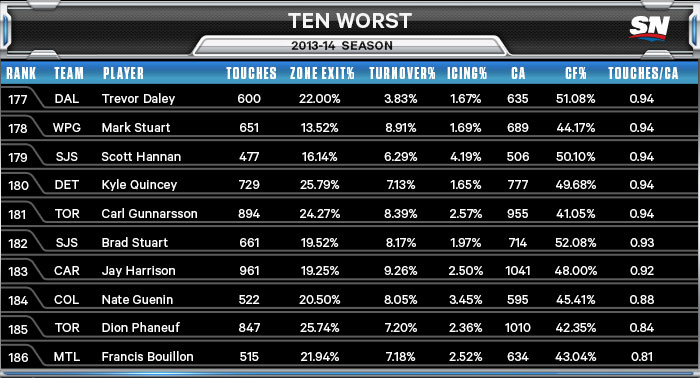Over the past two NHL seasons, in-depth analysis of the underlying facets of game play have led to an increased understanding of which specific events are driving observed outcomes. At the 2013 MIT Sloan Sports Analytics Conference, Eric Tulsky, Geoff Detweiler, Robert Spencer and Corey Sznajder presented a paper that—through manual tracking of Zone Entry events in 330 NHL games—identified that successfully transitioning into the offensive zone while maintaining possession of the puck greatly increased a team’s chances of generating shot attempts and, thus, scoring chances.
As a follow up, Sznajder—a well-known blogger who focuses his writing around the Carolina Hurricanes—spent this summer watching as many of 2013-14’s games as possible to record Zone Entry and Zone Exit data. It was, frankly, a gargantuan effort of single-minded focus that, because it was done by one person, minimized bias and errors. As of this writing, he had provided me with data for 824 of the 1,230 NHL games played last season.
For a limited time get Sportsnet Magazine’s digital edition free for 60 days. Visit Appstore/RogersMagazines to see what you’re missing out on.
The focus of much of the work done so far regarding zone entries and exits has been on success rates, with or without possession of the puck, and the impacts of the types of transitions (a carry-in, pass, or dump-in). As a corollary of those focuses, the defensive research to date has largely been centred around prevention of entries and the number of shot attempts allowed once the puck has entered the zone.
That’s what intrigues me—largely because the ability of NHL teams to reliably assess defensive skill in skaters has been lacking.
My own work this summer on delta Corsi (dCorsi) has led me to conclude that attempting to identify “skills” based purely on observed results can be misleading, because the context in which a skater is playing has a major bearing on what we see them produce. One of the values Sznajder has also been tracking is a value he refers to as “Touches”. He defines a Touch as a situation where the defending player gains control of the puck with the intention of exiting his defensive zone.
Shot-attempts against (also referred to as Corsi Against) are a negative outcome for any defensive unit, because any attempt—shot quality aside—could theoretically end up in the back of the net. The two key shot-attempt points to consider are: 1) the defensive unit does not have control of the puck; and 2) the offensive unit does and is in a position to potentially score a goal, no matter the actual likelihood.
Considering these two points, it’s logical that defensive-zone touches and shot-attempts against are at odds with one another. If we can describe the ratio between the two events, we can track a blueliner’s defensive skill when the puck is in his zone.
You would expect defensively skilled skaters to have more touches than shot-attempts against, leading to a Touches to Corsi Against (Touches/CA) ratio greater than 1.00. At the other end of the spectrum, players who struggle defensively should have a Touches/CA ratio below 1.00. And this is exactly the outcome when players are sorted using the Touches/CA statistic.
Here are the best and worst NHL defencemen in Touches/CA (min. 450 touches):


It seems obvious that those in the first list excelled at preventing opposition attempts last season, while the second group struggled mightily. Whether either is because of defensive structure is debatable, but usage factors should be less of a concern than with typical Corsi statistics because everyone is being compared in a defensive-zone context.
Let’s look at two up-and-coming blueliners: Jake Muzzin of the Kings and T.J. Brodie of the Flames. Both players are seeing top-end results so far in their careers. The kind that get guys into significant all-star discussion (or should). But raising their names as all-stars elicits responses to the effect of “Muzzin plays with Doughty” and “Brodie plays with Giordano.” Both of which are 100-percent true, and Doughty and Giordano are both very good. But what goes unnoticed—or, at least, often unsaid—is that Muzzin and Brodie have excellent results away from Doughty and Giordano, and both may actually be helping to push the results of their better known partners.
Look at the charts. Muzzin and Brodie are getting to more pucks than their partners. So are they being being carried? Or do they deserve more kudos? At the least, we should be watching to see if they can maintain their extremely high level of play. (For the full list, click here.)
This type of exploration of the underlying data is giving us a window into discerning which players are making significant impacts on the ice, and it’s a large part of why data-driven decision making is gaining momentum. If teams can identify earlier which players are doing more (or less) to help their teams succeed, fewer mistakes get made and teams should improve.

